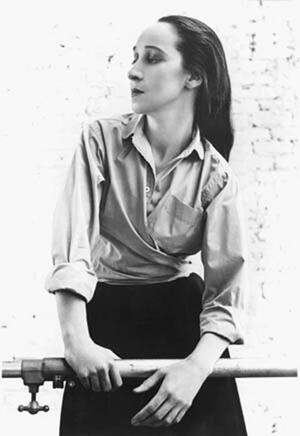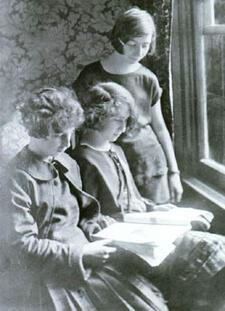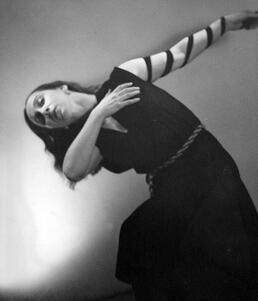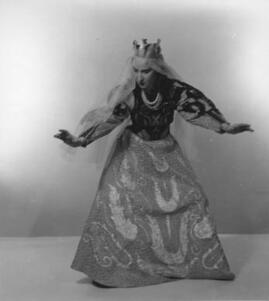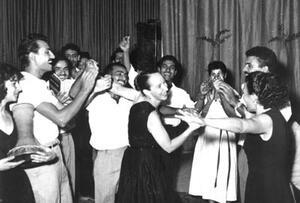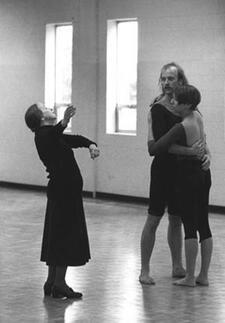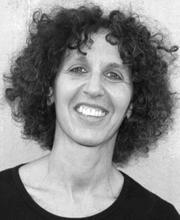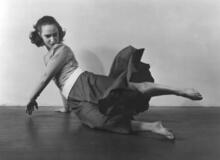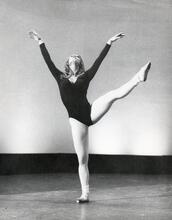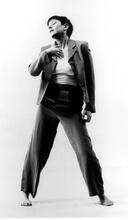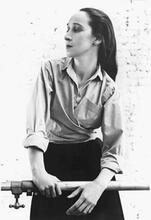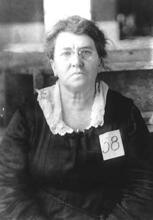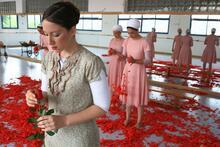Anna Sokolow
Anna Sokolow, the daughter of Russian Jewish immigrants to the United States, learned to dance on New York’s Lower East Side. She danced with the early Martha Graham Company and became a leading choreographer whose works reflect her intense commitment to the social, political, and human conflicts of her times. Her dances were created and shown internationally, particularly in Mexico and Israel, where she worked with the Yemenite dance company Inbal. She also collaborated with the Actor’s Studio with Elia Kazan. Her work was seen on and off Broadway and with her own company. Her most famous works include “Kaddish,” “Dreams,” and “Rooms.”
Anna Sokolow, the “rebellious spirit” of modern dance, was a member of the Martha Graham Company (1937–1940), on the faculty of the Juilliard School of Music, Dance Division (1958–1988), founder and director of La Paloma Azul Company (Mexico, 1940), the Lyric Theater (Israel, 1962), the Anna Sokolow Dance Company (1967), and the Players Project (1971), adviser to Inbal (1953), and choreographer of hundreds of dance works, plays, operas, Broadway musicals, and festivals. Her partners included musician Alex North, painter Ignacio Aguirre, and actor John Silvester White. In celebration of her 85th birthday in 1995, the dance world joined in tribute to her accomplishments and service, her pioneer work in Mexico and Israel, and, above all, her “blazing force and integrity.”
Family & Training
Anna Sokolow, the child of Russian Jewish immigrants Samuel and Sara Sokolowski, was born in Hartford, Connecticut, in 1910. The family moved to New York in 1912. Sara became the breadwinner for the family, working in the garment trade, active in the International Ladies Garment Workers Union (ILGWU) and the Socialist Party. At the Emanuel Sisterhoods of Personal Service, Anna took her first dance classes with Elsa Pohl, who taught interpretive dancing in the style of Isadora Duncan. Anna attended the Henry Street Settlement House and the original Neighborhood Playhouse, which had been established by Alice and Irene Lewisohn, wealthy Jewish women who were interested in dance and theater. Sokolow studied dance with Blanche Talmud, Irene Lewisohn, and Bird Larson. Given a full scholarship in 1928, she was invited to join the special classes of the Junior Festival Players when the Playhouse School opened on West 46th Street. There, her teachers included Martha Graham, Louis Horst, Michio Ito, and Benjamin Zemach, an exponent of Hebraic dance.
Choreography on Social, Political, and Human Conflicts
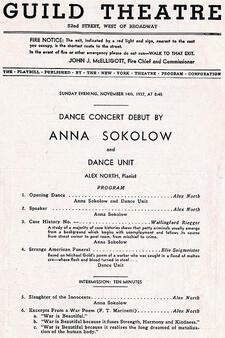
Institution: Jerome Robbins Dance Division, New York Public Library for the Performing Arts
Sokolow’s first theater appearance was in Ernest Bloch’s “Israel Symphony” in May 1928, staged by Irene Lewisohn. Her choreography closely reflects her intense commitment to the social, political, and human conflicts of her times. “City Rhythms,” a student work staged in 1931, reflected currents of her life and the rhythms of New York City, Moscow, Mexico City, and Tel Aviv. Other early works include the “Anti-War Trilogy (Anti-War Cycle)” of 1933. Performed with the Theater Union Dance Group, the piece was staged in three parts: I. Depression, Starvation, II. Diplomacy—War, and III. Protest (Defiance). This was the first use of the music of Alex North, Sokolow’s partner for many years. Sokolow received critical albeit high praise, since, from a Marxist position, “this piece proved that an individual, rather than collective creator, could produce work of high quality.”
In the Depression years, Sokolow, Sophie Maslow, and Helen Tamiris, all dancers with Jewish working-class origins, were mobilized by the union movement. Sokolow says, “The unions were really my first audience. Poets or writers would read their work, singers and dancers would perform in their halls.” Sokolow was regarded as an outstanding figure of the radical dance era. For the Works Progress Administration (WPA), she created the dances for “Sing for Your Supper,” a variety show primarily remembered because it contained the great narrative “Ballad for Americans.”
International and Jewish Work
Sokolow became a pioneering teacher and choreographer when she was invited to Mexico in 1939 by Carlos Mérida. Mexico was then a land fighting an artistic and social revolution. Rita Morgenthau helped get Sokolow’s company to Mexico. Mexico City audiences accepted her dancing, although the work was neither ballet nor folk dance. Away from New York, with a different tempo and culture, her work turned toward lyricism. Her company, “La Paloma Azul” [The blue dove], received acclaim, as did her production of the “Antigone Symphony” by Carlos Chavez.
With the circumstances of World War II, Sokolow began to choreograph using Jewish themes. She used passages from the Old Testament in 1943 as part of a Montreal Festival performance and “Songs of a Semite,” from a book of poems by Emma Lazarus, for a 1943 YMHA performance. In 1945 and 1946, she danced “The Bride” to “traditional Jewish music” and Lit. (Aramaic) "holy." Doxology, mostly in Aramaic, recited at the close of sections of the prayer service. The mourner's Kaddish is recited at prescribed times by one who has lost an immediate family member. The prayer traditionally requires the presence of ten adult males.Kaddish, wrapped in Phylacteriestefillin
Drawn to theater work, Sokolow choreographed dances for the drama “Street Scene” (1946) by Elmer Rice, to music by Kurt Weill and lyrics by Langston Hughes. Set in a crowded tenement in the Lower East Side, it was a natural idiom for her. She used the jitterbug and children’s games, dance vernacular now fully accepted but then very innovative. Sokolow had brought a popular social dance swing idiom to the Broadway stage. Her interest in theater brought her to the Actors Studio, Elia Kazan’s training school. A dance version of S. Ansky’s “The Dybbuk” marked her last concert appearance in 1951.
From Bullfight, a film by Shirley Clarke, 1955.
This film is the only extant recording of Anna Sokolow performing.
Courtesy of Wendy Clarke.
Theater, and in Israel, “The Treasure”(1962), a play based on a story by Isaac Leib Peretz. She staged vast festivals and fund-raising events after World War II on behalf of the Jewish National Fund and Bonds for Israel. These included the 1952 Purim Festival (with Sholom Secunda) at Madison Square Garden, the 1953 Fund-Raising for Israel Bonds: 3000th Anniversary of Jerusalem, and the 1954 Hanukkah Festival pageant (with Kim Stanley and Joseph Schildkraut). She staged opera at the New York City Center in 1956, including “Orpheus,” "La Traviata,” “The Tempest,” “L’Histoire du Soldat,” and “Carmen.”
“Rooms” (1955), Sokolow’s best-known late work, grew from sessions at the Actors Studio. It depicts the isolation of the urban dweller. Each dancer sits in a chair, reaching into space, close to one another, yet out of touch. The theme of the withdrawn sufferer appeared again in “Session ’58,” “Opus ’50,” “Opus Jazz 1958” in Israel, “Opus ’60,” and, finally, “Opus ’65” in the Joffrey Ballet Company’s repertory to Teo Macero’s jazz score.
Two works are worth special note. “Lyric Suite” (1953), choreographed to Alban Berg’s score, was premiered in Mexico and then performed at the YMHA in 1954 with such notables as Donald McKayle, Jeff Duncan, Ethel Winter, and Mary Antony. The use of Berg’s music and the emotive yet non-narrative choreography made this a landmark in modern dance work. Louis Horst said, “Anna, now you are a choreographer.” “Dreams” (1961), an “allegory of time and helplessness,” used concentration camp images. In Holland, audiences responded with the silence of recognition. On the fiftieth anniversary of the liberation, “Dreams” still had enormous impact.
In Israel, Sokolow brought her professional skills to Inbal, the Yemenite Company led by Sara Levi-Tanai. Inbal was then primarily a company of Yemenite folk dance. For Inbal, Sokolow staged the “Song of Songs” in 1976. With the Juilliard Dance Theater, she built a work called “Ellis Island”; for Batsheva, “Poems of Ecstasy.” In 1979, she choreographed “The Bible in Dance” in Jerusalem, using a setting of the “Song of Songs” by Sergei Rachmaninoff and “Psalms” by Gustav Mahler. In 1982, she created "Los Marranos” to Ladino folk songs. This versatile woman also did the original choreography for “Hair,” a mime-dance of Samuel Beckett’s “Act Without Words,” “Magritte, Magritte,” based on images from the painter’s works, and “From the Diaries of Franz Kafka,” a dance-theater work.
At the conference “Jews and Judaism in Dance” at the Joyce Theater in 1986, Anna Sokolow was celebrated as a prime mover in the dance world. Her work has been kept in repertory by Jim May’s company Anna Sokolow’s Player’s Project and Lorry May’s organization Sokolow Dance Foundation. Other entities, such as Dakshina/Daniel Phoenix Singh Dance Company, and numerous university dance departments, regular perform her repertory. Sokolow dedicated her works to such diverse people as Isadora Duncan, Anne Frank, Louis Horst, Langston Hughes, Franz Kafka, Golda Meir, Nijinsky, Bishop Pike, Alexander Scriabin, Hannah Szenes, and her parents. She gave dance and theater a heroism and passion exemplified by those she honors.
In 1985-86 Sokolow’s work “Rooms” was presented at the Paramount Theater, Oakland, danced by members of the Oakland Ballet, Ronn Guidi, director. A video-recording of that performance is available (upon request and agreement) from the Oakland Ballet.
Anna Sokolow died in New York City on March 29, 2000.
Baum, Charlotte, Paula Hyman, and Sonya Michel. The Jewish Woman in America. New York: Dial Press, 1975.
Clarke, Mary, and David Vaughan. The Encyclopedia of Dance and Ballet. New York: G.P. Putnam’s Sons, 1977.
Dance Magazine (June 1956, April 1969, April 1985, April 1991).
Dance News: The Season in Review (June 1964, February 1965).
Dance Observer (November 1943, October 1946).
Denby, Edwin. Dance Writings. New York: Knopf, 1986.
Jowitt, Deborah. “Anna at Eighty-five.” Dance Magazine 64, no. 8 (August 1995).
Kosstrin, Hannah. Honest Bodies: Revolutionary Modernism in the Dances of Anna Sokolow. Oxford: Oxford University Press, 2017.
Lloyd, Margaret. The Borzoi Book of Modern Dance. New York: A.A. Knopf, 1949.
Martin, John. America Dancing. New York: Dodge Publishing Company,1936.
Margin, John. The Dance. New York: Tudor Publishing Company, 1946.
Martin, John. Book of the Dance. New York: Tudor, 1963.
McDonagh, Don. The Complete Guide to Modern Dance. New York: Doubleday, 1976.
Morgan, Barbara. Martha Graham. New York: Duelll, Sloan and Pearce, 1941.
New Dance Group. Souvenir Program, June 11, 1993.
Studies in Dance History 5, no. 1. 'Of, by, and for the People: Dancing on the Left in the 1930s. Articles by Pricket, Graff, Ocko.
Warren, Larry. Anna Sokolow: The Rebellious Spirit. Pennington, NJ: Princeton Book Company, 1991.

